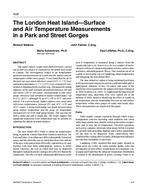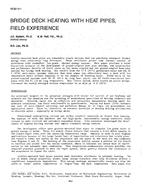Fire safety in buildings can be greatly improved by changing construction practices, modifying code requirements, and utilizing air-handling equipment to direct combustion gases into paths that would route smoke away from habitable areas. Buoyancy-induced movement of smoke and the resulting driving force, often referred to as stack effect, are particularly strong in tall buildings. The stack effect is responsible for drawing gases into vertical shafts at lower levels and expelling them at higher openings. In order to manage the movement of smoke throughout a tall building, a complete and detailed model, including the influence of the stack effect, is needed to analyze the factors that dictate how smoke moves throughout a building during a high-rise fire.
This paper describes a detailed computer program called COSMO that is based on fundamental principles of heat transfer, thermodynamics, and fluid mechanics. The program has several unique features. It is not only specifically designed to trace the vertical smoke movement in a tall building, but it also considers floor pressurization as a means to manage the smoke movement and improve occupant safety. Furthermore, the program includes a detailed heat transfer analysis that determines the temperature of the smoke as it moves upward in a vertical shaft. Finally, the program includes a detailed momentum balance on the flow of smoke in the shaft rather than assuming a hydro-static pressure distribution, which is a frequently used assumption for most other smoke movement programs.
The program is used to examine those factors that will effectively manage smoke movement and improve fire safety during a high-rise structural fire. Program results suggest that existing codes for elevator venting can have a detrimental effect on fire safety issues by inhibiting smoke from venting the building and forcing it into upper floors. The possibilities of pressurizing floors in a high-rise for the purpose of smoke management are examined. Results also show that modestsized air handlers can be used to keep smoke from reaching habitable spaces on upper floors, thereby greatly improving fire safety in buildings equipped with a floor pressurization system. Further improvements in the management of smoke movement can be achieved by selectively pressurizing only the upper floors in a building.
Units: Dual
Citation: ASHRAE Transactions, vol. 115, pt. 1, Chicago 2009
Product Details
- Published:
- 2009
- Number of Pages:
- 17
- File Size:
- 1 file , 600 KB
- Product Code(s):
- D-CH-09-019


